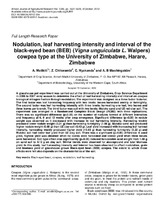| dc.contributor.author | Matikiti, A. | |
| dc.contributor.author | Chikwambi, Z. | |
| dc.contributor.author | Nyakanda, C. | |
| dc.contributor.author | Mashingaidze, A.B. | |
| dc.date.accessioned | 2016-06-13T14:47:07Z | |
| dc.date.available | 2016-06-13T14:47:07Z | |
| dc.date.issued | 2012 | |
| dc.identifier.citation | Matikiti, A. et al. (2012). Nodulation, leaf harvesting intensity and interval of the black-eyed bean (BEB) (Vigna unguiculata L. Walpers) cowpea type at the University of Zimbabwe, Harare, Zimbabwe. African Journal of Agricultural Research, 7(39): 5421-5429 | en_US |
| dc.identifier.issn | 1991-637X | |
| dc.identifier.uri | http://hdl.handle.net/10566/2311 | |
| dc.description.abstract | A glasshouse pot experiment was carried out at the University of Zimbabwe, Crop Science Department in 2006 to 2007 rainy season to determine the effect of leaf harvesting intensity and interval on cowpea biological nitrogen fixation through nodulation. The experiment was designed as a three factor factorial. The first factor was leaf harvesting frequency with two levels: leaves harvested weekly or fortnightly. The second factor was leaf harvesting intensity with three levels: harvesting one leaf, two leaves and three leaves per branch. The third factor was soil with two levels: Mutoko sand and UZ red clay soil. The experiment was arranged in a Randomized Complete Block Design (RCBD) with three replications. There was no significant difference (p>0.05) on the number of nodules formed at different intensities and frequency at 6, 9 and 12 weeks after crop emergence. Significant difference (p<0.05) in nodule weight was observed as it decreased with increase in leaf harvesting intensity. Harvesting weekly produced lower nodule weight (0.31 g) than harvesting fortnightly (1.08 g). Mutoko sand soil produced higher nodule weight (0.69 g) than UZ clay soil (0.43 g). Leaf yield increased with increasing leaf harvest intensity, harvesting weekly produced higher yield (10.43 g) than harvesting fortnightly (3.22 g) and Mutoko soil had lower leaf yield than UZ clay soil. There was a significant (p<0.05) difference in seed yield, highest yield was obtained when no leaves were harvested and lowest yield when three leaves were harvested. Soil type effect also significantly (p<0.05) reduced harvestable seed weight from 1.00 g on sand soil to 4.12 g on clay soil. Similar trends were observed for aboveground and total biomass yield. In this study, leaf harvesting intensity and interval has been observed to affect nodulation, grain and biomass yield of glasshouse grown Black-eyed bean (BEB) cowpea. The extent to which these effects were felt also depends on the characteristics of the soil. | en_US |
| dc.language.iso | en | en_US |
| dc.publisher | Academic Journals | en_US |
| dc.rights.uri | Academic Journals strongly supports the Open Access initiative. Abstracts and full texts of all articles published by Academic Journals are freely accessible to everyone immediately after publication. | |
| dc.source.uri | http://dx.doi.org/10.5897/AJAR12.954 | |
| dc.subject | Black-eyed bean | en_US |
| dc.subject | Cowpea | en_US |
| dc.subject | Nodulation | en_US |
| dc.subject | Leaf harvesting | en_US |
| dc.subject | Agriculture | en_US |
| dc.title | Nodulation, leaf harvesting intensity and interval of the black-eyed bean (BEB) (Vigna unguiculata L. Walpers) cowpea type at the University of Zimbabwe, Harare, Zimbabwe | en_US |
| dc.type | Article | en_US |
| dc.privacy.showsubmitter | FALSE | |
| dc.status.ispeerreviewed | TRUE | |

